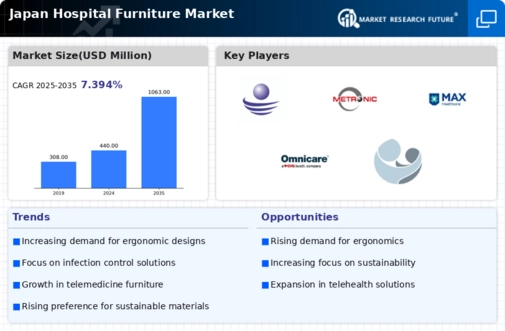Government Initiatives and Funding
Government initiatives aimed at improving healthcare infrastructure play a pivotal role in the Hospital Furniture Market. In Japan, substantial investments are being made to upgrade hospitals and clinics, which includes the procurement of modern furniture. The government has allocated approximately ¥1 trillion for healthcare improvements in the current fiscal year, which is likely to stimulate demand for hospital furniture. These initiatives not only enhance the quality of care but also ensure that healthcare facilities are equipped with the latest furniture designs that promote efficiency and patient safety. Consequently, the hospital furniture market is poised for growth as these funding efforts materialize.
Rising Patient-Centric Care Models
The shift towards patient-centric care models is reshaping the Hospital Furniture Market. In Japan, healthcare providers are increasingly focusing on creating environments that enhance patient comfort and satisfaction. This trend is leading to the development of furniture that is not only functional but also aesthetically pleasing. For example, the use of softer materials and customizable designs is becoming more common, as hospitals aim to create a welcoming atmosphere for patients. As the demand for patient-centric solutions grows, the hospital furniture market is likely to experience a corresponding increase in the adoption of innovative furniture designs that prioritize the patient experience.
Increased Focus on Infection Control
The heightened focus on infection control within healthcare settings is significantly influencing the Hospital Furniture Market. In Japan, hospitals are increasingly prioritizing furniture that is easy to clean and resistant to microbial growth. This trend is driven by the need to maintain high standards of hygiene and patient safety. Furniture made from non-porous materials and designed for easy disinfection is becoming essential. As healthcare facilities invest in furniture that meets these stringent infection control standards, the hospital furniture market is expected to expand, reflecting the growing awareness of the importance of cleanliness in healthcare environments.
Technological Advancements in Design
Technological advancements in design and manufacturing processes are transforming the Hospital Furniture Market. Innovations such as ergonomic designs, smart furniture, and modular systems are becoming increasingly prevalent. These advancements not only improve the functionality of hospital furniture but also enhance the overall patient experience. For instance, the integration of technology in hospital beds allows for better monitoring of patient health, which is crucial in a fast-paced healthcare environment. As hospitals in Japan adopt these new technologies, the demand for sophisticated furniture solutions is likely to rise, thereby propelling the hospital furniture market forward.
Aging Population and Healthcare Demand
The aging population in Japan is a critical driver for the Hospital Furniture Market. As the demographic shifts towards an older age group, the demand for healthcare services increases significantly. This trend necessitates the expansion and modernization of healthcare facilities, which in turn drives the need for advanced hospital furniture. According to recent statistics, the population aged 65 and over is projected to reach 28% by 2025, leading to a heightened requirement for hospital beds, examination tables, and other essential furniture. The hospital furniture market is expected to grow in response to this demographic change, as healthcare providers seek to enhance patient comfort and care quality.
















Leave a Comment